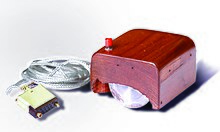Bill English (computer engineer)
Bill English | |
|---|---|
 William English in 2008 | |
| Born | William Kirk English January 27, 1929 Lexington, Kentucky, U.S. |
| Died | July 26, 2020 (aged 91) San Rafael, California, U.S. |
| Known for | Development of the computer mouse |
| Scientific career | |
| Institutions | SRI International's ARC Xerox PARC Sun Microsystems |
William Kirk English (January 27, 1929 – July 26, 2020) was an American computer engineer who contributed to the development of the computer mouse while working for Douglas Engelbart at SRI International's Augmentation Research Center.[1][2] He would later work for Xerox PARC and Sun Microsystems.
Early life
[edit]English was born on January 27, 1929, in Lexington, Kentucky. The only son of Harry English and Caroline (Gray) English, he had two half-brothers from his father's previous marriage. Harry English was an electrical engineer who managed coal mines and Caroline was a homemaker. William, or Bill as he was known, attended a boarding school in Arizona and then studied electrical engineering at the University of Kentucky.[3]
Career
[edit]English served in the US Navy until the late 1950s, including postings in northern California and Japan.[3] He then joined the Stanford Research Institute in the 1960s to work on magnets, and built one of the first all-magnetic arithmetic units with Hewitt Crane.[4] In 1964, he was the first person to join Douglas Engelbart's lab, the Augmentation Research Center.

He and Douglas Engelbart share credit for creating the first computer mouse in 1963; English built the initial prototype, and was its first user, based on Engelbart's notes.[5][6] English led a 1965 project, sponsored by NASA, which evaluated the best way to select a point on a computer display; the mouse was the winner.[4][7] English was also instrumental at The Mother of All Demos in 1968, which showcased the mouse and other technologies developed as part of their NLS (oN-Line System).[4][8] In particular, English figured out how to connect a terminal in the San Francisco Civic Auditorium to the host computer at SRI 30 miles (48 km) away, and also transmitted audio and video between the locations.[4][8]
He left SRI in 1971 and went to Xerox PARC, where he managed the Office Systems Research Group. While working at PARC, English developed a ball mouse, in which a ball replaced the original set of wheels.[2] It worked similarly to a moveable ball-based mouse device called Rollkugel, which had been developed by Telefunken, Germany, and was offered since 1968 as input device for their computers.[5][9]
In 1989, he went to work for Sun Microsystems on internationalization efforts.[2]
English died of respiratory failure in San Rafael, California, on July 26, 2020, aged 91.[3][6]
References
[edit]- ^ Shearer, Benjamin F. (2007). Home Front Heroes: A Biographical Dictionary of Americans During Wartime. Greenwood Publishing Group. p. 277. ISBN 9780313334214. Retrieved December 9, 2018.
- ^ a b c "Bill English". Computer History Museum. Archived from the original on January 4, 2012. Retrieved February 3, 2013.
- ^ a b c Metz, Cade (July 31, 2020). "William English, Who Helped Build the Computer Mouse, Dies at 91". The New York Times. Retrieved July 31, 2020.
- ^ a b c d "Alumni Hall of Fame 2006: Bill English". SRI International. Archived from the original on July 1, 2013. Retrieved January 25, 2013.
- ^ a b "Auf den Spuren der deutschen Computermaus" [In the footsteps of the German computer mouse] (in German). Heise Verlag. April 28, 2009. Retrieved January 7, 2013.
- ^ a b "Computer mouse co-creator dies at 91". BBC News. August 3, 2020. Retrieved August 4, 2020.
- ^ "Mouse". Doug Engelbart Institute. Retrieved January 25, 2013.
- ^ a b Hintz, Eric (December 10, 2018). "The Mother of All Demos". Smithsonian Institution. Retrieved August 2, 2020.
- ^ "Telefunken's 'Rollkugel'". oldmouse.com.
